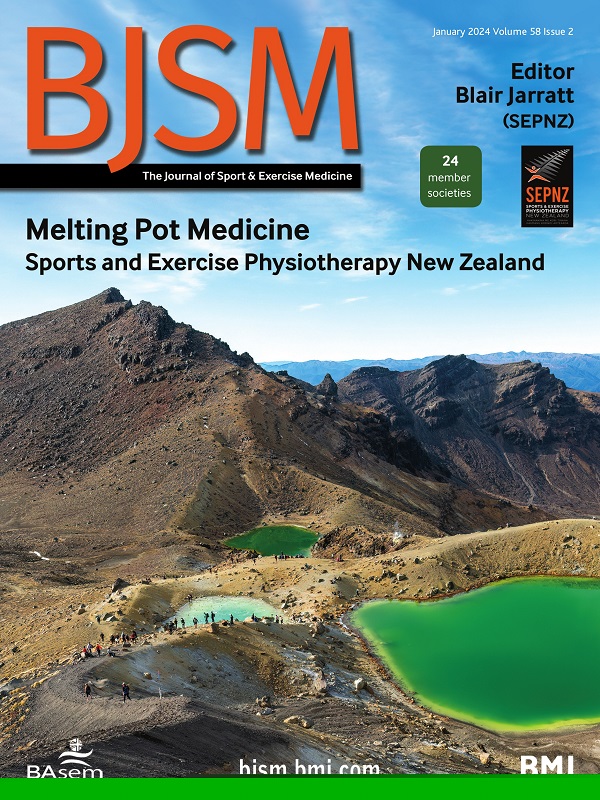下肢损伤的预防策略:对女性、女性和女孩运动员损伤预防(FAIR)共识的系统回顾和荟萃分析
IF 16.2
1区 医学
Q1 SPORT SCIENCES
引用次数: 0
摘要
目的探讨减少女/女/女运动员下肢损伤的预防策略的有效性和意想不到的后果。设计系统的评价与荟萃分析和分级的建议,评估,发展和评价。数据来源系统搜索八个数据源。主要数据研究与对照组一起调查运动相关LE损伤的伤害预防策略,每个研究组中≥1名女性/女性/女孩。结果在82项研究中,包括48项随机对照试验(59%)、16项准实验研究(20%)、16项队列研究(20%)和1项横断面研究(1%),共纳入154 561名参与者,其中84 915名(55%)为女性/妇女/女孩。以神经肌肉训练(NMT)为基础的方案(n= 60,73%)是最常被研究的干预措施,其次是个人防护装备(PPE) (n= 9,11%)、政策/规则改变(n= 4,5%)和教育(n= 6,7%)。所有研究的Downs和Black评分中位数为17(范围:5-24)。9项研究汇总结果的点估计显示,NMT计划,包括LE平衡,力量,敏捷性和方向改变练习,每周两次最小剂量10分钟,将女/女/女运动员的LE损伤减少19% (0.81,95% CI 0.61%至1.08%;低确定性证据)。6项研究汇总结果的点估计显示,NMT可减少39%的踝关节扭伤(0.61,95% CI 0.36%至1.03%;中等确定性证据)。NMT可显著减少61%的前交叉韧带(ACL)损伤(0.39,95% CI 0.25% ~ 0.60%;高确定性证据)。结论NMT方案可以减少女/女/女运动员前交叉韧带损伤61%,踝关节扭伤39%,强调了广泛实施NMT方案的必要性。需要提供个人防护装备、政策/规则变化和教育方面的证据,以防止女/女/女孩运动员的LE伤害。普洛斯彼罗注册号CRD42024486715。如有合理要求,可提供资料。在向通讯作者提出合理要求时,可以提供未识别的数据。请给通讯作者发一份书面提案,概述具体的研究目的和分析计划,以及为什么需要这些具体的数据。机构之间需要签署正式的数据共享协议。本文章由计算机程序翻译,如有差异,请以英文原文为准。
Prevention strategies for lower extremity injury: a systematic review and meta-analyses for the Female, Woman and Girl Athlete Injury Prevention (FAIR) Consensus
Objective Examine the effectiveness and unintended consequences of prevention strategies for reducing female/woman/girl athletes’ lower extremity (LE) injuries. Design Systematic review with meta-analyses and Grading of Recommendations, Assessment, Development and Evaluation. Data sources Systematic search of eight data sources. Eligibility Primary data studies with a comparison group(s) investigating injury prevention strategies for sport-related LE injuries with ≥1 female/woman/girl in each study group. Results Across 82 studies—including 48 randomised controlled trials (59%), 16 quasiexperimental studies (20%), 16 cohort studies (20%) and 1 cross-sectional study (1%)—a total of 154 561 participants were included, of whom 84 915 (55%) were females/women/girls. Neuromuscular training (NMT)-based programmes (n=60, 73%) were the most frequently studied intervention, followed by personal protective equipment (PPE) (n=9, 11%), policy/rule change (n=4, 5%) and education (n=6, 7%). The median Downs and Black score for all studies was 17 (range: 5–24). Point estimate from pooled results from nine studies revealed that NMT programmes, which include LE balance, strength, agility and change of direction exercises, with a minimum dose of 10 min two times per week, reduced female/woman/girl athletes’ LE injuries by 19% (0.81, 95% CI 0.61% to 1.08%; low certainty evidence). Point estimate of pooled results from six studies uncovered that NMT reduced ankle sprains by 39% (0.61, 95% CI 0.36% to 1.03%; moderate certainty evidence). NMT significantly reduced anterior cruciate ligament (ACL) injuries by 61% (0.39, 95% CI 0.25% to 0.60%; high certainty evidence). Conclusion NMT programmes can reduce female/woman/girl athletes’ ACL injuries by up to 61% and ankle sprains by 39%, highlighting the need for widespread implementation of NMT programmes. Evidence informing PPE, policy/rule changes and education to prevent female/woman/girl athletes’ LE injuries is needed. PROSPERO registration number CRD42024486715. Data are available upon reasonable request. Deidentified data can be made available upon reasonable request to the corresponding author. Please email the corresponding author with a written proposal outlining the specific research aims and analysis plan and why these specific data are needed. A formal data sharing agreement between institutions will be required.
求助全文
通过发布文献求助,成功后即可免费获取论文全文。
去求助
来源期刊
CiteScore
27.10
自引率
4.90%
发文量
217
审稿时长
3-8 weeks
期刊介绍:
The British Journal of Sports Medicine (BJSM) is a dynamic platform that presents groundbreaking research, thought-provoking reviews, and meaningful discussions on sport and exercise medicine. Our focus encompasses various clinically-relevant aspects such as physiotherapy, physical therapy, and rehabilitation. With an aim to foster innovation, education, and knowledge translation, we strive to bridge the gap between research and practical implementation in the field. Our multi-media approach, including web, print, video, and audio resources, along with our active presence on social media, connects a global community of healthcare professionals dedicated to treating active individuals.

 求助内容:
求助内容: 应助结果提醒方式:
应助结果提醒方式:


